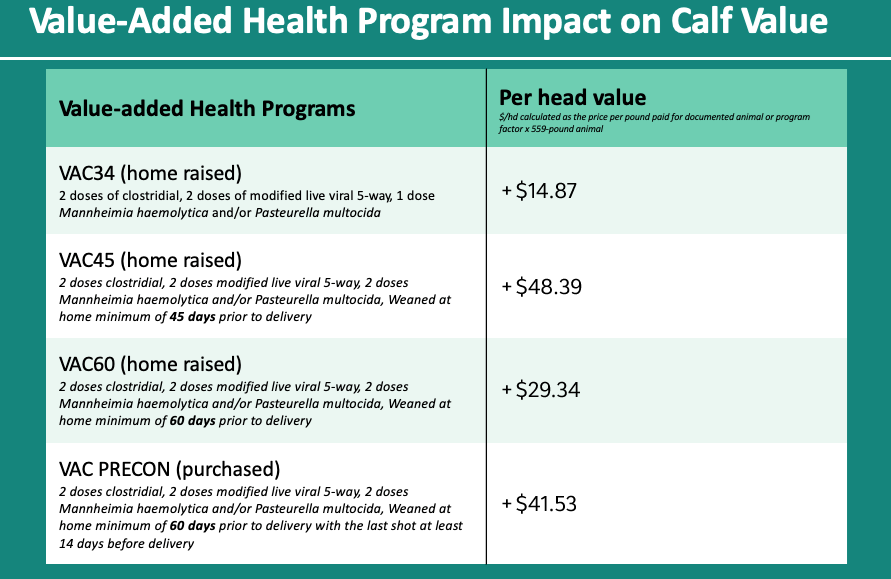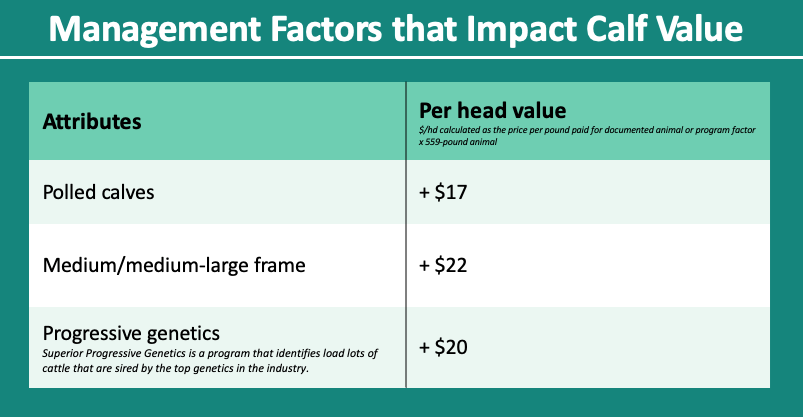What practices pay off at the auction block?
By John Hutcheson
As cattle producers sit in auction barns or on the video and watch their calves sell, they often wonder why their calves don’t sell for more. What makes buyers pay more for some calves and not others? There are several different management scenarios, programs and health protocols, so evaluating them and their revenue impact can be overwhelming.
To make it easier, Merck Animal Health, Superior Livestock Auction and Kansas State University work together to evaluate the management decisions, programs and health protocols that drive the price per pound paid by buyers. The 2023 auction dataset includes information from 898,500 calves with an average weight of 571 pounds.1 The average price nationally was $2.63 per pound.
Each trait was evaluated relative to a base with all other factors being constant. So, an additive approach can be used when evaluating multiple traits.

VAC45 added $45 per head
Preconditioning boosts the immune system, health status and increases weight, helping equip calves to thrive in a backgrounder or feedyard phase. A successful preconditioning program includes a series of vaccinations, and management practices, such as weaning, deworming, and transitioning calves to dry feed, as well as possibly implanting, castrating and dehorning. Preconditioning programs are generally grouped into the following classifications: VAC24, VAC34, VAC45, VAC60 and VAC PRECON.
VAC45 calves, that is, those vaccinated with two doses of a clostridial vaccine, two doses of a five-way modified live viral vaccine, and at least one dose of Mannheimia haemolytica and/or Pasteurella multocida vaccine, and weaned at home for 45 days before delivery, added $7.86/cwt compared to those receiving only one dose of each of the three vaccines and weaned at shipping.2 Not to mention, calves weighed more at the end of a 45-day preconditioning program than those weaned at sale time.
Selling calves on a VAC45 program added nearly $45 per head.

BOVILIS® PrimeVAC™ by Merck Animal Health is a value-added preconditioning program that focuses on respiratory and clostridial vaccinations, as well as protection against internal parasites. It also includes optional implant protocols. It gives producers a clear guide of the steps needed to give calves the best start, and it enables producers to demonstrate their preconditioning efforts with a certificate through the program.
Kansas State University and Merck Animal Health have created a resource to help producers evaluate the cost-return of calf vaccination programs.
The implant advantage
Some management decisions do not change the price received for calves. One such management decision is implanting calves. Over the last four years, in over 4 million head of cattle evaluated, there has not been a difference in price per pound paid between implanted and non-implanted calves. Therefore, producers may be leaving money on the table if they are not implanting.
Overall, implants consistently increase average daily gain by 20%.3 Calves implanted at 2+ months of age will on average weigh 23 pounds heavier, be leaner and have a slight increase in frame compared to non-implanted calves.4 Using calf prices during this period translates to $59 per head advantage at the sale block compared to calves that were not implanted.
Marketing programs
Unless calves ultimately are marketed in verified Non-Hormone Treated Cattle (NHTC) programs that offer a premium that outweighs the productivity and efficiency of gains from implants, calves that are destined for finishing and sale to a terminal market should be implanted to capture increased revenue. For example, in the Superior Livestock Auction database, calves sold in the NHTC program received a premium of $37 more per head.
Global Animal Partnership (GAP) program calves sold for $25 more per head. Certain nutrition programs added value at sale time as well.
When it comes to marketing programs for your calves, consider all input costs for participation, such as EID tags, on-site third-party audits, developing quality manuals, etc.
Other factors that deliver value
Selling no-horn calves, having medium- to large-frame calves and using known bulls with high genetic merit all positively impacted value. Calves with continental breeding were discounted $10 per head compared to English breeding.

Cattle producers should ask themselves what practices they are not currently doing that can have a positive influence on the price per pound of the calves they are selling. Then, balance the costs and rewards of these different decisions and develop a marketing plan for their calf crop.
For resources on the PrimeVAC program, visit cattlefriendlyvaccines.com.
References
- Superior Livestock Auction Data 2023.
- Glynn T. Tonser. Dept. of Agricultural Economics. Kansas State University. Evaluation of 2023 Superior Livestock Auction data.
- Kentucky Comparative Study with Steers: Revalor®-G (trenbolone acetate and estradiol), Ralgro® (zeranol), Synovex®-S (progesterone/estradiol benzoate) and Control. Technical Bulletin #11. Merck Animal Health. May 2017.
- Selk, G. Implants for Suckling Steer and Heifer Calves and Potential Replacement Heifers. Symposium Proceedings: Impact of Implants on Performance and Carcass Value of Beef Cattle. 1997. Oklahoma Agricultural Experiment Station. P-957.
Find more content for your beef operation.
About the author

John Hutcheson, Ph.D.
Director, Cattle Technical Services,
Merck Animal Health
